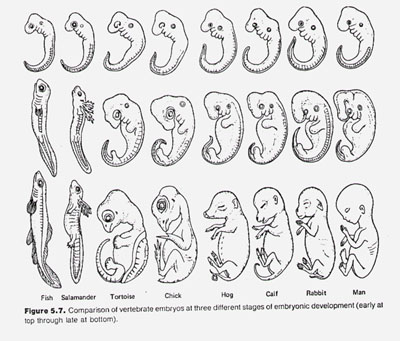
Evidence for Evolution:
Homology, Development and Adaptation
I. Evolution is theory and a fact.
A. Theory refers to an idea which is well supported by evidence. A hypothesis is
a tenative explanation for an observation in nature. The theory of evolution by natural
selection is well supported by scientific observations and research in nature.
B. It is a fact that changes in allele frequencies occur from one generation to another.
Scientists often debate and disagree about the relative importance of the various
agents of evolution, but there is no dispute that change occurs.
II. Four lines of evidence for evolution.
A. Natural species show extensive variation.
1. Previous examples have emphasized variation within species.
2. Presence of distinct species may lead people to believe that each has a separate
origin, but there are examples of natural variation creates a continuous set of intermediates
between two species. (Ex. Herring gull and lesser black-backed gull)

B. On a small scale, by small mean observable by humans as opposed to a geological
time scale, evolution can be observed in nature. (Examples shown in previous lectures)
C. Evolution can be produced experimentally. (Examples from previous lectures)
D. A pattern of descent with modification is evident among organisms based on evidence
from homologous traits.
1. For example, all vertebrates share a basic 5 digit limb system and modifications
have occurred.
2. There are also compelling homologies from vertebrate embryology. Ernst Haeckel
(1834-1919) emphasized similarities among vertebrate embryos—even human embryos have
gill slits, indicating modifications have occurred from aquatic ancestors.

3. Gastrulation. Invagination of cells that occurs in gastrulation is thought to
be a functional necessity when cells have flagella. Although many organisms no longer
have flagella at this stage, the invagination remains.
4. Homologies at molecular level incorporate similarities at a much wider scale than
just among vertebrates.
a. The translation between base triplets of DNA to amino acids is virtually a universal
code to all life. One can isolate messenger RNA for hemoglobin from a rabbit, inject
it into E. coli, a bacteria. Although E. coli do not normally make Hb, but will when
injected, indicating the same code is used in bacteria and rabbits. (The universal
code is necessary for recombinant DNA technology.). There exists no known chemical
limitation which indicates that a particular codon or three base sequence should
code for a particular amino acid. No spatial reason why certain codons would be linked
with amino acids. More likely, it is a historical accident and evidence of ancient
homologies.
b. Amino acid sequences in different proteins reveal that different species consistently
share similar sequences rather. This was done for 5 different proteins of 11 different
vertebrate species. Some species have more similar protein sequences—shown by have
a shorter branching distance from each other on an evolutionary tree. For the five
proteins—trees for all are very similar. There are 34, 459,425 different possible
trees—but similarities reveal only a subset of trees. Example: HAR and K. Common
ancestry or descent with modification explains why should be strong similarities
among same species for all 5 proteins since modifications occurred from a common
ancestor.

c. For amino acid sequences of pax gene, there is a 90% similarity between humans
and fruitflies.
5. There are also examples from the fossil record of shared common ancestry among
extinct species. Evolution of the horse:
a. First fossils date from about 60 mya, horses were rather small, and had 4 toes
on front, 3 on back, different teeth structure, suited for eating soft tissue of
leaves, and short legs.
b. In lineages that persisted, increased in size, legs lengthened, decrease in #
of toes, change in tooth structure. Changes associated with changes in habits—grasslands
were spreading, tooth modifications for change from browsing on soft tissue to eating
grasses that have silica in them, present teeth good for grinding. Lengthening of
legs may have been a response to increased predation pressure of open habitat.

6. Allometric relationships also reveal evidence of shared common ancestry. Allometry refers to correlation among body parts. Large people have large everything not just one part. Allometric relationships in part due to pleitropic effects of genes, or genes that influence one trait also have influences on others. Allometric relationships among species occur supporting the idea of common ancestry since changes among body parts has occurred together. If no common ancestry, there is no reason to expect an allometric relationship.

7. Analogous characters support the theory of evolution by natural selection. Cacti
and euphorbs. Sunbirds and hummingbirds. North American and Australian mammals.